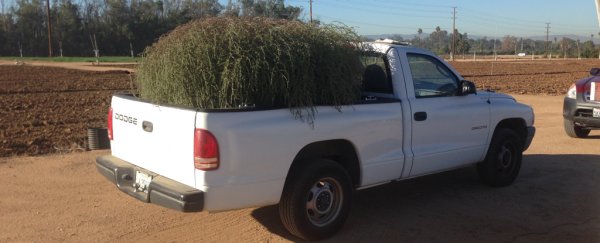It was supposed to be extinct by now. The invasive tumbleweed Salsola ryanii only popped up on scientists' scopes in 2002, but early research concluded it was nothing to worry about.
A 2008 study predicted S. ryanii wouldn't easily adapt, nor be able to expand its range. Those predictions have not aged well.
Since the newly identified species was first detected in California, this gigantic tumbleweed – which can grow to over 6 feet tall in height – has rapidly expanded its presence in the state, and scientists have now figured out the secret of its vigour and virulence.
"Salsola ryanii is a nasty species replacing other nasty species of tumbleweed in the US," says geneticist Norman Ellstrand from University of California, Riverside.
"It's healthier than earlier versions, and now we know why."
Victorville neighborhood overrun by tumbleweeds! @CBSLA pic.twitter.com/pFzxZIIIQ4
— Tina Patel (@tina_patel) April 17, 2018
There wasn't always an S. ryanii, scientists say. It's thought the species evolved sometime in the last 25 to 100 years. Exactly when remains uncertain, but we do know where it came from.
S. ryanii is a hybrid: a species formed from two other invasive tumbleweeds. Its progenitors – or parents – are Salsola tragus (native to Russia and China, and invasive in 48 US states) and Salsola australis (native to Australia and South Africa, and invasive in California and Arizona).
When these two infamous weeds had their tumble in the hay and bestowed S. ryanii upon the world, they spawned not just a hybrid plant, but a polyploid: an organism with multiple sets of chromosomes.
As it happens, S. ryanii is no regular polyploid, but an allopolyploid, which is when a polyploid organism derives its multiple sets of chromosomes from two or more diverged taxa.
According to Ellstrand and his colleague Shana Welles, a plant evolutionary ecologist now at Chapman University, allopolyploidy in plants has long been speculated to confer increased fitness – genetic advantages that somehow enable the hybrid to survive amidst competition with its already established, populous parents.
That's the thinking, at least, but little experimental research has actually been conducted to test the hypothesis.
To rectify that, the researchers conducted two year-long experiments to see how S. ryanii thrived compared to its progenitors in a test garden site in California.
The results showed that the hybrid outgrew its parents in both plant mass and volume, which are commonly used proxies of plant fitness in this kind of research.
In other words, the offspring appears to be more invasive than its already highly invasive parents, which between them have already spread and tumbled across some 48 states.
"Our data provide support for the hypothesis that allopolyploidisation has the potential to increase invasiveness," the authors write in their paper.
"The relatively high vigour of S. ryanii compared to its progenitors demonstrates that the allopolyploid has the potential to maintain or increase its invasiveness."
Of course, we already knew this hybrid invader posed a problem. Previous research by the same team in 2016 looked at how fast S. ryanii was spreading in California.
"In 2002, the year the new species was found, researchers found it at only two sites," Josh Hrala explained for ScienceAlert. "But in 2012, the team found it at 15 sites."
That rate of spreading might be unprecedented, the researchers said.
"To our knowledge, this is the fastest documented population number expansion of a newly formed allopolyploid species – perhaps the most dramatic known range expansion of any plant neospecies," the team explained at the time.
Given the extreme havoc its progenitor S. tragus can wreak in a high wind, it's clear this even more vigorous offspring is something we need to watch closely.
The findings are reported in AoB Plants.
